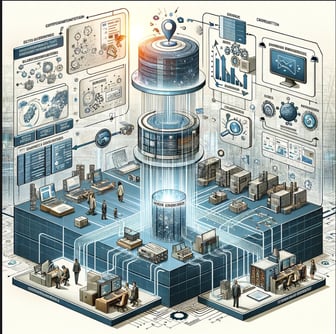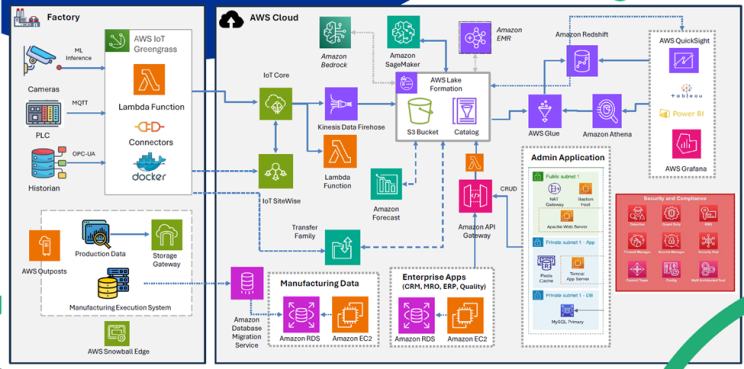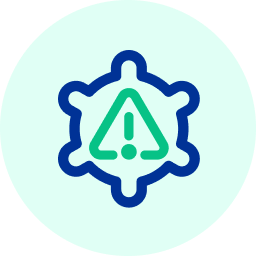In today's highly regulated and data-driven pharmaceutical and biotechnology industries, the quest for operational excellence, quality assurance, and cost optimization has never been more pressing. As companies grapple with the complexities of Good Manufacturing Practices (GMP) compliance and the ever-growing volumes of data, the integration of Artificial Intelligence (AI) and Machine Learning (ML) emerges as a game-changer.
This whitepaper aims to illuminate the vast potential of AI/ML in GxP manufacturing, providing a comprehensive roadmap for life science organizations to embark on a transformative journey.
“50% of companies that embrace ML & AI over the next five to seven years have the potential to double their cash flow with manufacturing leading all industries due to its heavy reliance on data.” -- McKinsey
The main problem in GxP manufacturing can be summarized in one sentence: “There is a lot of data, but very little intelligence!” Implementing AI is less about technology, but more about data.
Typically, pharma manufacturing has a lot of data that is well structured and available. Maybe it is time to thank the FDA for this situation. However, data is in many silos: Historical Data, CMMS Data, Alarms Data, Batch Records, Lab Test Data, etc.. The mere existence of data is not enough; the true challenge lies in harnessing this data to drive meaningful change, predict future outcomes, and deliver corrective actions in near real-time.
Then what is the problem?
How can an organization analyze billions of records to understand what is going on, predict what is going to happen and deliver corrective actions in near real-time?
 The problem is not lack of data but a cohesive approach to convert this data into actionable knowledge in near real-time. The problem is also delivering information to the right people at the right time forcing them to take actions that will increase efficiencies. What I mean is that the actionable data needs to be delivered from the operator level all what up to senior management.
The problem is not lack of data but a cohesive approach to convert this data into actionable knowledge in near real-time. The problem is also delivering information to the right people at the right time forcing them to take actions that will increase efficiencies. What I mean is that the actionable data needs to be delivered from the operator level all what up to senior management.What needs to be done?
- Define Clear Objectives: Establish clear and measurable objectives for AI/ML projects based on the true needs of the business, rather than solely relying on the available technology toolset.
- Assemble a Cross-Functional Team: Create a dedicated team that includes leadership representatives from various departments, such as process, operations, quality, as well as subject matter experts in AI/ML, data science, and IT.
- Develop a Project Charter: Collaboratively develop a comprehensive project charter that outlines the scope, objectives, timelines, and key milestones for the AI/ML implementation.
- Data Source Analysis: Conduct a thorough analysis of the various data sources required to meet the project objectives, ensuring data quality and identifying any necessary data cleansing operations. These datasets may include time-series data from production lines, alarms, defect reports, batch records, product quality data, laboratory data, sensor/device configurations, maintenance and repair logs, and more.
- Design a Data Lake: Layout a design for a Data Lake that will house all this data including data refresh mechanisms.
- Select a Proof-of-Concept (PoC) Candidate: Identify a suitable PoC candidate that aligns with the project objectives and provides a solid foundation for demonstrating the potential of AI/ML in GxP manufacturing.
- Iterative Development: Break down the project into smaller, manageable phases or sprints, each with a clear "Definition of Done" (DoD) to facilitate iterative development and continuous improvement.
- Infrastructure Design: Design the infrastructure to ingest the data into the data lake, perform data analysis (AI/ML Engine) and communicate the results to the appropriate personnel.
- Cloud Implementation: : Leverage cloud platforms such as AWS or Azure, which provide comprehensive toolsets and services for building and deploying AI/ML solutions in a secure and scalable manner.
- Iterative Model Refinement: Assess the model outputs in an iterative fashion, constantly finetuning. Also, incorporate model training into AIOps.
- Evaluate Progress: Regularly evaluate the progress against the defined DoD for each phase or sprint, iterating as necessary until the PoC is successfully completed.
- Go-Live and Training: Deploy the PoC solution in a production environment, providing comprehensive training and education to all involved personnel, and continuously improve the model through feedback and ongoing training.
- Enterprise-wide Rollout: Develop a robust framework for model deployment and roll out the AI/ML solution across the enterprise, leveraging the lessons learned and best practices from the PoC implementation.
Note: It is crucial to note that any efforts undertaken prior to 2023 may need to be reevaluated, as the advent of Generative AI (GenAI) Foundational Models has redefined the possibilities and capabilities of AI/ML solutions. These cutting-edge models offer unprecedented potential for innovation and transformation in GxP manufacturing.
What can be expected? What are the possibilities?
The implementation of AI/ML in GxP manufacturing unlocks a world of possibilities and tangible benefits that can drive operational excellence, enhance quality control, and optimize resource utilization. Some of the key possibilities and benefits include:
- Pattern Recognition and Root Cause Analysis: AI models can assimilate data from diverse sources to identify patterns, trends, and correlations that may be imperceptible to human analysts. By leveraging historical data and establishing "gold standard" runs, these models can monitor processes in real-time, predict deviations from optimal performance, and suggest potential root causes for deviations.
- Predictive Maintenance and Asset Optimization: Machine learning algorithms can predict equipment failures with remarkable accuracy, enabling predictive maintenance strategies that reduce unnecessary downtime and maximize asset reliability. Studies have shown that deploying machine learning and predictive analysis can increase overall equipment efficiency by an average of 45% to 52%.
- Automated Quality Control: AI-powered computer vision algorithms can learn from historical data to distinguish between acceptable and defective products, automating the inspection and supervision process.
- Chatbot Interfaces: Intuitive chatbot interfaces can provide line operators, automation experts, and process engineers with immediate access to critical information and insights, reducing the need to navigate through multiple screens and systems.
- Intelligent Reporting: AI-driven reporting systems can not only provide real-time status updates but also offer in-depth analysis and explanations for observed trends, enabling data-driven decision-making at all levels of the organization
According to Forbes, "Machine learning-based automated quality testing can increase detection rates by up to 90%."
Key Benefits
Operational Efficiency
Through machine learning and artificial intelligence, manufacturing systems can determine the optimal configuration for systems for optimized throughput, reduce quality issues, reduce wastage, and increase output. An optimal monitoring and remediation process will provide the business users with insights around key metrics assisting in iterative OE cycles.
Predictive Maintenance
Machine learning enables predictive maintenance by predicting equipment failures before they occur and reducing unnecessary downtime. Machine learning algorithms can predict equipment failure with an accuracy of 92%, allowing businesses to plan their maintenance schedules more effectively, improving asset reliability and product quality. Studies show that by deploying machine learning and predictive analysis, overall equipment efficiency increased by an average of 45% to 52%.
Quality Control
Machine learning models are being used for product inspection and quality control. ML-based computer vision algorithms can learn from historical data to distinguish good products from faulty ones, automating the inspection and supervision process. Machine learning offers significant savings in visual quality control in manufacturing.
"AI and machine learning can help manufacturers increase overall equipment effectiveness by up to 20 percent and reduce manufacturing costs by up to 10 percent." - McKinsey
What does the architecture of the infrastructure look like?
It does vary depending on various factors. I have included sample diagrams for a PoC as well as a fully functional system.
 Sample Architecture for a PoC
Sample Architecture for a PoC

Sample Architecture for a Large Scale Production System
Conclusion:
The integration of AI/ML in GxP manufacturing represents a pivotal opportunity for life science organizations to unlock unprecedented levels of operational efficiency, quality control, and cost optimization. By leveraging the power of advanced analytics and machine learning, companies can gain a competitive edge and drive sustainable growth in an increasingly data-driven and regulated environment.
With a well-defined roadmap, a collaborative cross-functional team, and a robust infrastructure, organizations can navigate the complexities of AI/ML implementation and reap the rewards of enhanced pattern recognition, predictive maintenance, automated quality control, and intelligent reporting.
As the life science industry continues to evolve, embracing the transformative potential of AI/ML will be a key differentiator for those companies that seek to remain at the forefront of innovation, compliance, and operational excellence.
The future of GxP manufacturing lies in harnessing the power of data, and AI/ML represents the catalyst that can turn this data into actionable intelligence, driving the industry towards a new era of efficiency, quality, and success.
What questions do you have about artificial intelligence in Life sciences? No question is too big or too small. Submit your questions about AI via this survey here.


COMMENTS